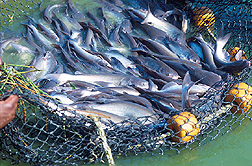Purrfecting the Catfish
|
||
|
Whether blackened or fried, baked or broiled, catfish is a favorite catch, particularly in the South. Now, eaters and producers alike should have no problems finding the "purrfect" fillet.
Research to develop meatier, tastier, and faster growing catfish is paying off. Agricultural Research Service scientists at the Catfish Genetics Research Unit (CGRU) in Stoneville, Mississippi, have bred a new catfish variety—USDA 103—scheduled to be made available to catfish producers in February 2001. ARS will release the new catfish jointly from the Thad Cochran National Warmwater Aquaculture Center with the Mississippi State University Agricultural and Forestry Experiment Station, Mississippi State, Mississippi.
|
|
|
It's one of the few times genetic research has improved catfish since the industry started in the United States during the late 1950s. Since then, catfish has become one of the most successful aquacultural enterprises. Genetic research on channel catfishthe most commonly used species—began in the mid-1960s. But producers have been waiting for development of a new higher performing catfish variety. Since the industry's inception, genetic improvement has not had a significant effect on commercial production in the major catfish-producing states—Alabama, Arkansas, Louisiana, and Mississippi.
The release of USDA 103 should change that. "It usually takes catfish 18 to 24 months to go from birth to market. This new catfish variety grows 10 to 20 percent faster in the pond, and it's ready for market sooner than other varieties—an advantage for producers," says geneticist William R. Wolters, who heads the CGRU.
|
|
|
USDA 103 consumes 10 to 20 percent more feed than other catfish. But since the feed costs only 10 cents per pound, producers are gaining a return on their investment because they can often get 70 to 80 cents per pound for the fish.
"This new fish also has good reproductive characteristics," notes Wolters. "Some USDA 103 catfish can reach sexual maturity at 2 years of age—a year faster than current catfish. The new variety starts producing eggs sooner and produces more eggs than some fish now raised commercially." "I think this new variety is great," says catfish farmer H. Austin Jones, who raises about 35 million catfish fingerlings (small fish) and 3 million food fish on 1,045 acres of water in Moorehead, Mississippi. "I only have one growing season to get my fish ready, so I'm excited about USDA 103 because it will mean I can get a larger fish to the market faster," Jones says. This new fish is the cat's meow. In taste tests comparing it with other catfish lines, a quality panel selected cooked USDA 103 fillets as one of their favorites. Wolters says the quality of fresh, frozen, and cooked fillets is comparable to that of other popular catfish strains. |
|
|
New Tools Spawn Better Fish
Aside from genetics, high-tech instruments are helping to boost catfish production. ARS geneticist Brian G. Bosworth is using ultrasound to see the internal anatomy of catfish. It's the same technology that allows an expectant mother to see her baby—and even possibly predict the child's health. Ultrasound uses reflected sound waves to produce a gray-scale image of the catfish's internal anatomy. Different tissues have different reflective properties. "Using an ultrasound machine, we can measure the size of the muscle," Bosworth says. "From that measurement we can estimate the fillet yield of a live catfish." Fillet yield is the meat from the whole fish. The cattle and swine industries use this technology to measure carcass traits, like backfat and loin area, but no one has ever used it to measure fish muscle mass. "Ultrasound measurements are a good indication of which fish have higher fillet yield. Now we're breeding those fish to see if they produce offspring with higher fillet yields," Bosworth says. |
|
|
Bosworth is adapting another procedure from human medicine to predict the fat content in catfish. Typically used to quantify lean muscle mass, total body moisture, and body fat, bioimpedance measures resistance to a harmless, low-level electrical current passed through electrodes in live, tranquilized fish. Resistance is related to the amount of water and fat in the fish. The more fat, the more resistance. Using this method, Bosworth says he can measure fat levels in live fish and determine which fish would make the best genetic contribution to developing a low-fat catfish.
Another phase of the research involves evaluating fillet yield in different catfish families. "Members of a family have some genes in common, so by determining how similar the yield is in family members, we can get an idea of which fish have the best genes for increased fillet yield," Bosworth says. "Measuring and evaluating traits in families has been used in other livestock species, but we are just starting with this approach in catfish."—By Tara Weaver-Missick, Agricultural Research Service Information Staff. This research is part of Aquaculture, an ARS National Program (#106) described on the World Wide Web at http://www.nps.ars.usda.gov/programs/appvs.htm. William R. Wolters and Brian G. Bosworth are in the USDA-ARS Catfish Genetics Research Unit, P.O. Box 38, Stoneville, MS 38776-0038; phone (662) 686-3596, fax (662) 686-3567. |
|
|
"Purrfecting the Catfish" was published in the January 2001 issue of Agricultural Research magazine. |
||











